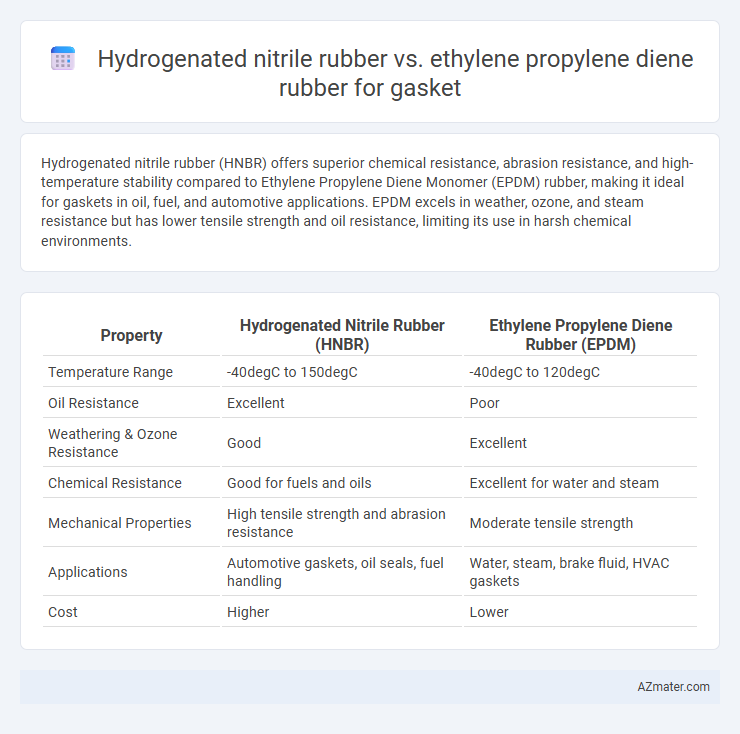Hydrogenated nitrile rubber (HNBR) offers superior chemical resistance, abrasion resistance, and high-temperature stability compared to Ethylene Propylene Diene Monomer (EPDM) rubber, making it ideal for gaskets in oil, fuel, and automotive applications. EPDM excels in weather, ozone, and steam resistance but has lower tensile strength and oil resistance, limiting its use in harsh chemical environments.
Table of Comparison
| Property | Hydrogenated Nitrile Rubber (HNBR) | Ethylene Propylene Diene Rubber (EPDM) |
|---|---|---|
| Temperature Range | -40degC to 150degC | -40degC to 120degC |
| Oil Resistance | Excellent | Poor |
| Weathering & Ozone Resistance | Good | Excellent |
| Chemical Resistance | Good for fuels and oils | Excellent for water and steam |
| Mechanical Properties | High tensile strength and abrasion resistance | Moderate tensile strength |
| Applications | Automotive gaskets, oil seals, fuel handling | Water, steam, brake fluid, HVAC gaskets |
| Cost | Higher | Lower |
Introduction to Gasket Materials
Hydrogenated nitrile rubber (HNBR) offers excellent resistance to heat, oil, and chemicals, making it ideal for gaskets exposed to harsh automotive and industrial environments. Ethylene propylene diene monomer (EPDM) rubber provides superior weather, ozone, and steam resistance, which is crucial for gaskets used in outdoor or high-moisture applications. Selecting between HNBR and EPDM depends on specific gasket performance requirements such as temperature range, chemical exposure, and durability.
Overview of Hydrogenated Nitrile Rubber (HNBR)
Hydrogenated nitrile rubber (HNBR) offers superior resistance to heat, oil, and chemicals compared to traditional nitrile rubber, making it highly suitable for gasket applications in automotive and industrial environments. Its enhanced hydrogenation process improves thermal stability and mechanical properties, allowing it to withstand temperatures up to 150degC and aggressive fluids without degradation. HNBR's excellent abrasion resistance and low permeability further ensure reliable sealing performance in demanding conditions where ethylene propylene diene monomer (EPDM) may fall short.
Overview of Ethylene Propylene Diene Rubber (EPDM)
Ethylene Propylene Diene Monomer (EPDM) rubber is a synthetic polymer commonly used for gaskets due to its excellent resistance to weathering, ozone, UV rays, and aging, making it ideal for outdoor and automotive applications. EPDM maintains flexibility and sealing performance across a wide temperature range from -40degC to 150degC and exhibits strong resistance to water, steam, and polar solvents. Compared to Hydrogenated Nitrile Rubber (HNBR), EPDM offers superior performance in non-oil-based environments but has lower resistance to oils and fuels.
Comparative Chemical Resistance
Hydrogenated nitrile rubber (HNBR) exhibits superior chemical resistance to oils, fuels, and aliphatic hydrocarbons compared to ethylene propylene diene monomer (EPDM), making it ideal for applications involving petroleum-based fluids. EPDM offers excellent resistance to heat, ozone, and weathering but performs poorly against petroleum oils and hydrocarbons. For gaskets exposed to aggressive chemicals like hydraulic fluids and fuels, HNBR provides enhanced durability and longevity.
Temperature Performance Comparison
Hydrogenated nitrile rubber (HNBR) offers superior temperature resistance, typically withstanding continuous exposure from -40degC to 150degC, making it suitable for high-temperature gasket applications. Ethylene propylene diene rubber (EPDM) operates effectively within a lower temperature range, generally from -50degC to 130degC, which limits its use in extreme heat conditions. The enhanced thermal stability of HNBR results from its saturated polymer backbone, providing better performance in hot oil and steam environments compared to EPDM gaskets.
Mechanical Properties: Strength and Flexibility
Hydrogenated nitrile rubber (HNBR) offers superior tensile strength and excellent abrasion resistance, making it ideal for gaskets exposed to high pressure and mechanical stress. Ethylene propylene diene rubber (EPDM) provides outstanding flexibility and elasticity, maintaining performance across a wide temperature range and excellent resistance to weathering and ozone. While HNBR excels in strength and chemical resistance, EPDM is preferred for applications requiring greater flexibility and durability in harsh environmental conditions.
Weathering and Ozone Resistance
Hydrogenated nitrile rubber (HNBR) exhibits superior weathering and ozone resistance compared to ethylene propylene diene rubber (EPDM), making it ideal for gaskets exposed to harsh environmental conditions. HNBR's enhanced chemical structure provides better durability against ozone cracking and UV degradation, ensuring long-term gasket performance. EPDM, while effective in resisting ozone and weathering, generally performs best in moderate exposure, making HNBR the preferred choice for extreme outdoor applications.
Cost and Availability Analysis
Hydrogenated nitrile rubber (HNBR) offers superior chemical resistance and durability compared to ethylene propylene diene monomer (EPDM), but typically comes at a higher cost due to its complex production process. EPDM is widely available and more cost-effective, making it a preferred choice for gaskets in applications where extreme chemical exposure is less critical. Cost efficiency and ease of procurement often drive the selection of EPDM gaskets in large-scale manufacturing, while HNBR is favored in specialized environments requiring enhanced performance.
Typical Applications in Gasket Manufacturing
Hydrogenated nitrile rubber (HNBR) is widely used in gasket manufacturing for applications requiring high resistance to heat, oil, and chemicals, making it ideal for automotive, industrial, and oilfield gaskets. Ethylene propylene diene rubber (EPDM) excels in gasket applications where exposure to weathering, ozone, and steam is prevalent, commonly found in HVAC systems, water seals, and roofing gaskets. The choice between HNBR and EPDM depends on the specific environmental conditions and chemical exposures encountered in the sealing application.
Conclusion: Choosing Between HNBR and EPDM for Gaskets
Choosing between Hydrogenated Nitrile Rubber (HNBR) and Ethylene Propylene Diene Monomer (EPDM) for gaskets depends on specific application requirements. HNBR offers superior resistance to oils, fuels, and high temperatures, making it ideal for automotive and industrial sealing applications exposed to harsh chemicals. EPDM excels in weather, ozone, and steam resistance, making it more suitable for outdoor, HVAC, and water-related gasket applications.

Infographic: Hydrogenated nitrile rubber vs Ethylene propylene diene rubber for Gasket
 azmater.com
azmater.com